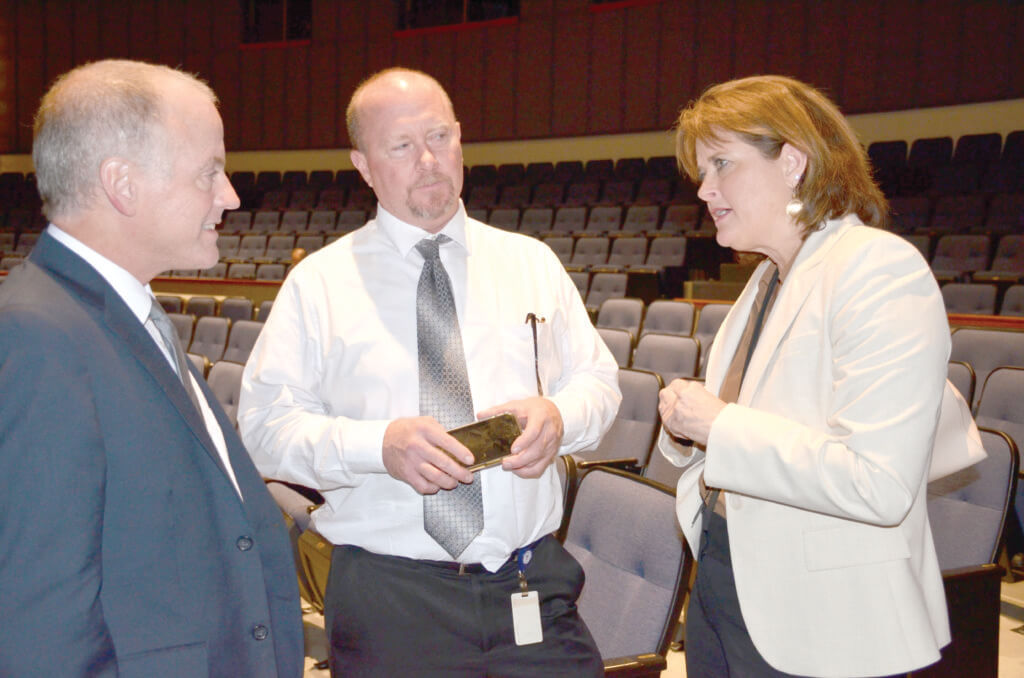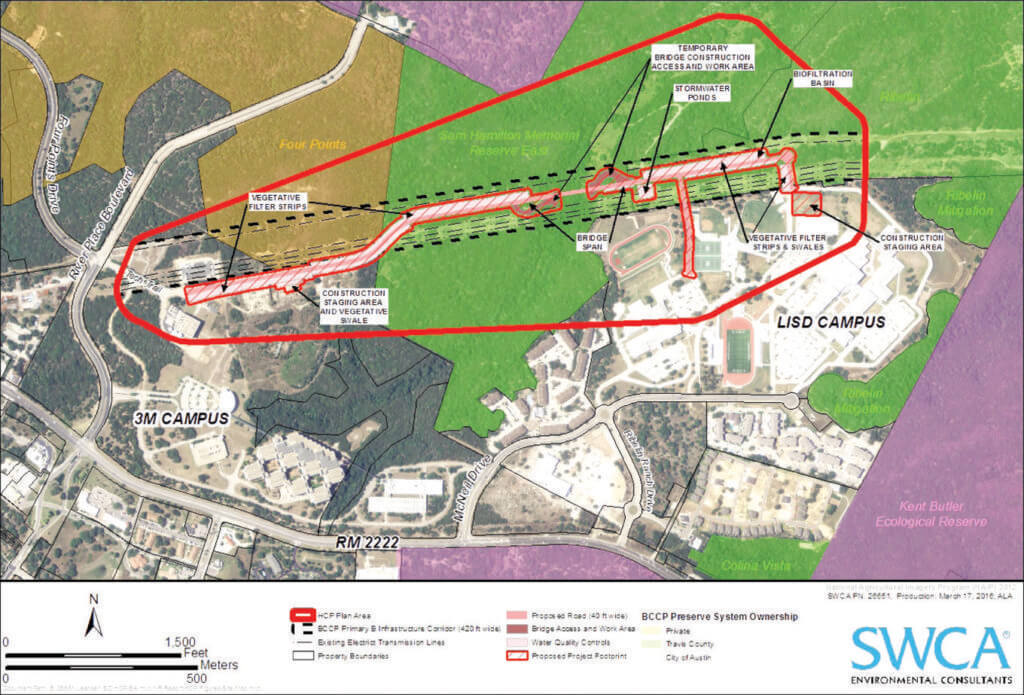
(Right) Pam Waggoner, Leander ISD Board of Trustees president and founder of the Four Points Traffic Committee, updated the community on the progress of the second access road to Vandegrift at the LISD community meeting on Sept. 27 at VHS. (L-R) Jimmy Disler, LISD chief facilities and operations officer, Charlie Little, VHS principal, and were at the presentation.

Leander ISD is proposing a second access road behind Vandegrift through the Balcones Canyonlands Preserve that would be one mile with a 100-foot right of way and an 800-foot bridge to protect habitat below.
Second meeting this week
By LYNETTE HAALAND
Four Points News
Leander ISD has a second meeting this week with local representatives of the U.S. Fish & Wildlife Service as it continues the discussion on building a second access road to Vandegrift HS through the Balcones Canyonlands Preserve.
The first meeting was Sept. 13 and school officials say it was successful.
“The first one was a very good meeting,” said Jimmy Disler, LISD chief facilities and operations officer. “We worked together, addressed concerns. Everyone got different tasks to complete and information to gather. Both sides were getting information. The meeting this week is to continue dialogue with them. It’s been positive so far. We’re happy.”
Background
In 2006, LISD wanted to build a high school in the south end of the district and the property where Vandegrift and Four Points MS are today was the only available, 100-acre site that met the districts requirements at the time, officials said.
The district wanted to build a second access road since the beginning of the new schools but the site borders the Balcones, which has rules about development and setting aside land in exchange for development. The mitigation was already done on the land before LISD bought it.
School construction began in 2008 and from 2009 to 2016, LISD did not get very far in its efforts to build a second access road. Through the years, the district reached out to the city of Austin, Travis County and nearby property owner 3M, which announced the sale of its property in July. Even though there were many meetings there was little to no progress.
Some four years ago, the Four Points Traffic Committee — which was started by LISD Board of Trustees president Pam Waggoner and champions the cause of traffic relief and a second VHS road — started getting together with the Balcones Canyonlands Conservation Plan group, which primarily included the city of Austin mayor, a Travis County Commissioner and a city of Austin administrative assistant.
“Working with them, there were a lot of issues and lot of uncertainty on what it (LISD’s road proposal through the Balcones Canyonlands) would do to their status of their 10(a) permit if LISD were to do this,” Disler said.
“That’s when we decided to file our own application for an incidental take permit under section 10(a) of the Endangered Species Act. This is so we wouldn’t jeopardize what they (the city and the county) had. A separate permit could resolve questions and concerns the staff brought up that would violate their 10(a),” Disler said.
In June 2016, LISD submitted its official incidental take permit (ITP) application along with the Habitat Conservation Plan (HCP). This was a large and thorough set of documents.
LISD’s plan would create a one-mile road along the existing 420-foot-wide infrastructure corridor that is in the BCP. The corridor has four electrical transmission lines, a buried 10-foot water line and an electrical substation.
Months later in February 2017, LISD got back a two-page response from its ITP and HCP, and it was a “repeat of what we heard in the past,” Disler said. That is when the district knew it needed to exercise a bolder strategy.
In late May, LISD hosted a community meeting and asked the local residents to reach out to U.S. lawmakers and ask for their support. It launched the #BuildTheRoad campaign.
Federal attention
The efforts culminated in letters being sent to Ryan Zinke, U.S. Secretary of the Interior. A couple of months ago, one letter was sent to Zinke that was jointly signed by five U.S. congressmen, and a week or so ago, another letter signed by two U.S. senators was sent to Zinke.
Both letters urged Zinke to help move forward the plans to issue a permit that would allow the road project to move forward, Disler said.
With this high level of attention, a first meeting was set with LISD and local representatives of the U.S. Fish and Wildlife on Sept. 13. The second meeting is this week.
Disler attributes these meetings and the progress as a result of the #BuildTheRoad campaign.
“This caused, in our mind, for us to be able to sit down at the table and talk about it (with USFWS),” he said. “We are working together to get a solution. It’s good for both sides. We are just as concerned about the environment as they are.”
The local office has been very cooperative, and very productive, Disler said. During the first meeting in September, they discussed the merits of the project, concerns, what needs to be addressed and how to move the plans forward.
USFWS has a process on how they work on such things.
“It is very structured in how they go through it. They keep the politics out,” Disler said.
Part of the 10(a) application is proposing for mitigation.
In LISD’s case, there are several options that could potentially happen. One option is to pay into a mitigation bank, Disler said. Another option is they could trade the land for the road for another piece of conservation easement land. There are such easements in various places including the Marble Falls area, and different groups manage such easements.
LISD has experience with working on environmental concerns. When it built Vista Ridge High School, which opened in 2003, the district had to spend nearly $500,000 for conservation easements because there were golden-cheeked warblers on the property where Reagan Elementary, John Gupton Stadium, and Vista Ridge are located.
Next steps
If plans continue forward to obtain the 10(a) permit for the VHS road, then it would go to a public comment period.
“My guess is that in the next two to three months we’d have a public comment period,” Disler said. “This week’s meeting will really give us a good indication.”
Then after a public comment period, USFWS has time to respond and review the application again to see if they need to address anything else.
If everything goes forward, it typically takes a year to 18 months, before a permit would be issued.
“It is a slow process,” Disler said. “Now that we’re at least talking, we believe we are on the right path now.”
